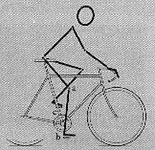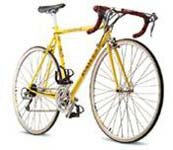 For this you will need to have a plumb line - a string (about 24") with a weight on the end and a helper.
For this you will need to have a plumb line - a string (about 24") with a weight on the end and a helper.
Pedal for a minute or two. Your helper should pay attention to the angle that your foot is in (heel up, heel down, neutral) when it hits the 3 o'clock position. Now placing your pedal in the 3 o'clock position (holding your foot at the correct angle) you will drop the plumb line from your knee noting the relative fore / aft distance from the plumb line to the pedal axle.
If you are 5'2" to 5'8" with average shoe size and pedal at a moderate rpm, then the line should pass through the pedal axle. If you are taller, or have proportionately larger feet or favour pushing larger gears at a slower cadence, then the line should fall slightly behind the pedal axle.
Conversely, if you are shorter or have smaller feet or tend to spin at higher rpm, then the line should fall through or ever so slightly in front of the spindle. It's all proportionate, ... a 6 footer, with size 10 (44) shoes that pedal with a moderate cadence, may have an ideal knee position about 15mm behind the pedal.
In mountain biking, the tendency is to pedal with a somewhat slower cadence so generally people are set up with the line slightly behind (5mm) the axle ... and up to 2cm behind the axle for very tall cyclists. Ultimately, you will fine-tune this position by making small adjustments and trying them out for a few rides.
 Hopefully you will be able to adjust your fore / aft position sufficiently by sliding your saddle on its rails. If you cannot move the saddle enough (and you already own your bike), then a change of seatpost may offer the added bit you need. Many seatposts are on the market and you will notice different styles and locations of the clamp. Some are along the centre line of the seatpost while others, in varying degrees are offset to the front or to the rear of the post. If you are buying a new post (or a new bike) it is always desirable to have room for adjustment both fore and aft if possible.
Hopefully you will be able to adjust your fore / aft position sufficiently by sliding your saddle on its rails. If you cannot move the saddle enough (and you already own your bike), then a change of seatpost may offer the added bit you need. Many seatposts are on the market and you will notice different styles and locations of the clamp. Some are along the centre line of the seatpost while others, in varying degrees are offset to the front or to the rear of the post. If you are buying a new post (or a new bike) it is always desirable to have room for adjustment both fore and aft if possible.
This is where the seat tube angle of the frame comes in. Ideally the saddle should both be in the correct fore / aft position for pedalling and the saddle should be clamped in the middle of the rail travel, so you will always have room for adjustments either way. A frame with a seat tube angle of 73 degrees will accommodate better than 80% of cyclists along with proper selection of the seat post.
Once the fore / aft has been set, you should re-check the saddle height. If you needed to move the saddle back, you will probably need to lower the saddle slightly, if brought forward, you will need to raise the saddle.
A Serotta Size-Cycle and appropriately trained technician is available in the form of James Huggins, of Rock 'n' Road Cycles. If you like what you hear in this section please with your details and we will be happy to pass them on to James. James also imports the complete range of Serotta bikes from the USA so again if you are interested in further details and we'll do the necessary.